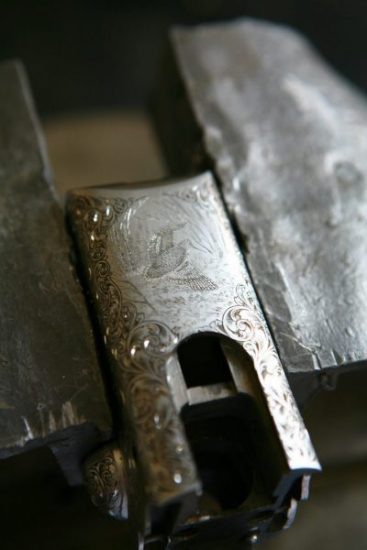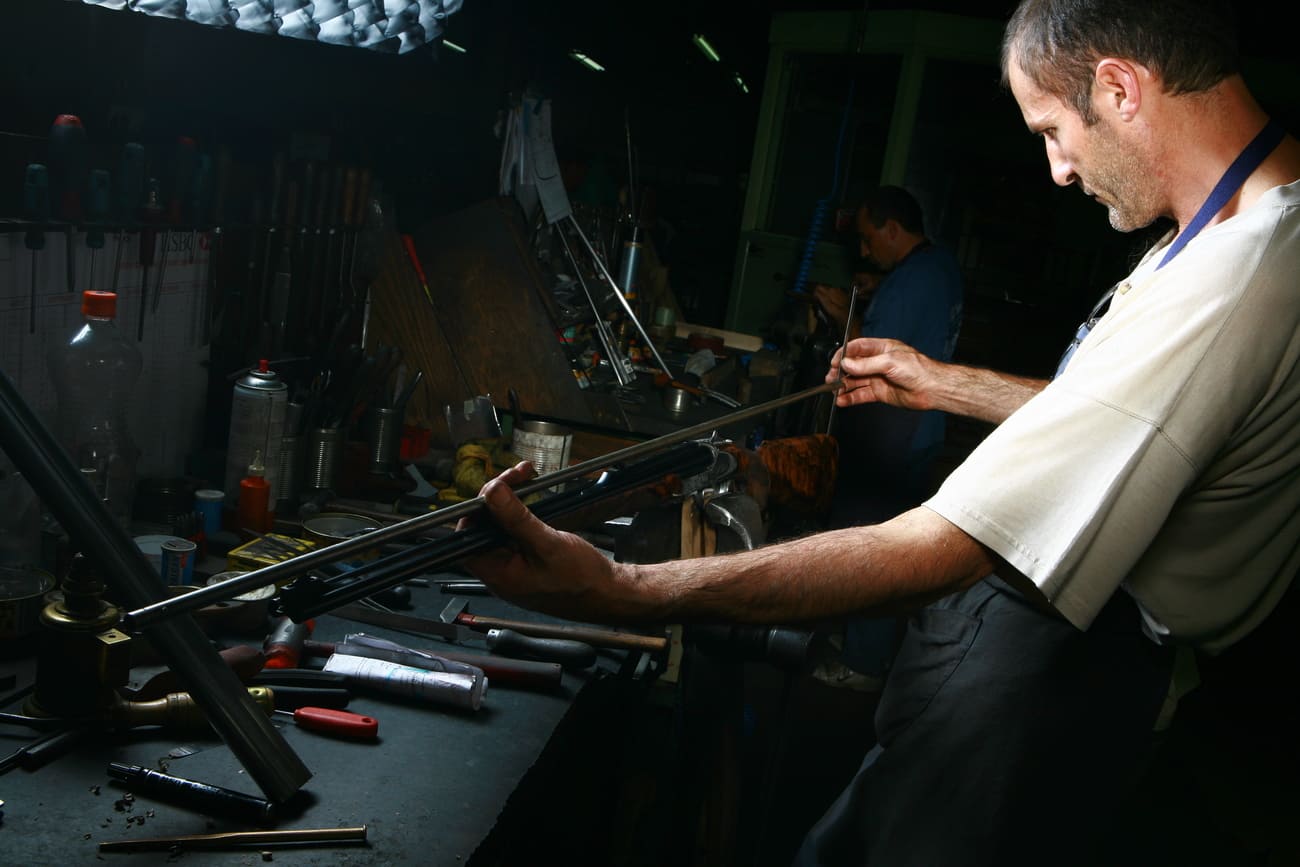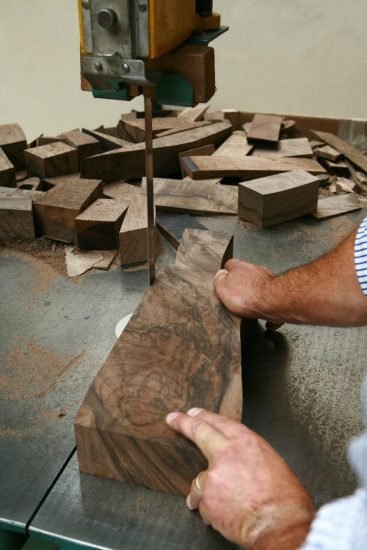Un nouveau réseau de distribution
Fruit de notre alliance avec le groupe Beretta, nous sommes heureux d’officialiser notre nouveau réseau de distribution mondial avec les 14 principales filliales étrangères

Making a hunting rifle is an art in itself. It requires mastery of several specialities: it is the work of a whole range of craftsmen. Gunsmiths, crossbowmen, gunsmiths, shooters or woodworkers, the making of a hunting rifle requires great precision on the part of the craftsmen, to produce a weapon with ideal performance and quality finishes. Discover the stages in the traditional manufacture of a hunting rifle.
An essential part of an express rifle, the rocker is made from raw metal, such as ergal or steel. The metal is worked by machines that cut the raw material to the required shapes and sizes. The result is an almost finished piece, with finishing touches such as polishing still to be carried out: it’s a delicate operation that requires an experienced hand.
Once the piece has been machined and polished by hand, it is time to engrave it. Rockers are engraved either by laser or, more traditionally, by hand by engravers. The rocker is then surface-tempered to protect it from oxidation.
The engravings, a veritable goldsmith’s art seen on many hunting rifles, are done by hand. Engraving is an art in its own right, and there are several different techniques: intaglio, intaglio, bulino and chasing. To find out more about engraving, discover the art of engraving on hunting rifles.
Adjusting the barrel to the rocker is a key stage in the manufacture of a rocking rifle. Smoke-black tilting is the most widely used traditional technique: it consists of filing the barrel to fit it perfectly to the rocker, using the traces left by the smoke-black on the points of contact between the two parts during the adjustment process.

The first stage is machining the hoop. The machine removes the material from a cylindrical metal bar, at the end of which the hoop is mechanised.
Like the hoop, the iron fronts are made from blocks of steel. To optimise the use of raw materials, iron fronts are usually made from the same block, i.e. head to tail, in opposite directions.
There are usually two intermediate strips. Like twins, they are machined from the same piece of metal. One-piece bands are not very common, but do exist on certain rifle models, a technique used by Chapuis Armes.
Rifles are synonymous with rifled barrels. There are various methods for rifling tubes. The traditional method involves manual rifling using a tool that cuts the inside of the barrel. This time-consuming method is no longer appropriate. Today, scratches are obtained by cold hammering, the most precise technique in terms of manufacturing: this involves using hydraulic hammers to strike the metal in order to impregnate the scratches on a mandrel inserted into the tube, by tightening the material on this matrix. Other manufacturing processes are also used, such as olive bluing or broaching.
Assembly of the barrel is a stage carried out by the expert hand of the gunsmith. He assembles the hoop, the intermediate bands, the tubes and the stock hook. First, the barrel tubes are fitted to the cradle. In good quality guns, the tubes are not interchangeable, and the assembly must be carried out in the correct direction. Next, the intermediate bands are placed in contact with the fret by the gunsmith. Each part must be carefully adjusted and positioned. Once adjusted, the assembly is passed through a furnace to solder the parts together, either with silver or tin. On leaving the barrel, a thorough cleaning is carried out by the gunmaker to get rid of any excess solder.
Next comes the bronzing stage: this involves oxidising the barrel to give it its characteristic black colour. Different methods exist, such as dip tanning.

Focus Chapuis Armes: machining
At Chapuis Armes, machining is carried out on state-of-the-art “five-axis” machines. This manufacturing process produces parts with ultra-precise, constant dimensions, for improved fit and optimised tolerances between them.
When it comes to stock, the choice of wood is crucial. You need a quality wood for a technically interesting and visually pleasing end result. Walnut is the wood of choice for making hunting rifles.
Usually, walnut stock are made from pre-cut models by machines and then refined by hand by the stockmaker. Modern synthetic stocks are generally moulded.
Now that the stock has been shaped, it is hollowed out to accommodate the weapon’s mechanism. The stock and toggle are assembled by the woodworker, who, once they have been adjusted, locks the stock to the toggle by means of the tie rod that connects the two parts.
The stock is prepared before being squared. Sanded and oiled is a technique used in high-end manufacture: the stock is sanded and then oiled several times over several days. The wood of the stock is now nourished, with a shiny appearance and enhanced grain.
It is then the turn of the squarer to apply his expertise, an extremely delicate operation that requires impeccable dexterity. The squaring is often done by a woman, who is more skilful in her movements.

In France, all firearms must be tested by the National Proof House. This is a compulsory stage. A tested weapon can be recognised by the stamp it carries, which certifies that it has passed the test.
The National Proof House inspector first inspects the various components of the weapon, including the barrel, the internal dimensions and the rocker mechanism. Then comes the test phase. The shooter tests the rifle with overpressure cartridges. Once the rifle has been tested, it must be adjusted. A final check of the parts after firing is carried out. The shooter adjusts the convergence by turning the screws to move the position of the barrels on models with mechanical adjustment. Once the gun has been reassembled, another test is carried out. The shooter must obtain a better grouping than on the first shots.
On average, 30 shots are fired per weapon on the test bench.
Focus Chapuis Armes: the proof bench
Chapuis Armes has an in-house proof house. Twice a month, a sworn inspector from the National Proof House in Saint Etienne comes to the premises in Saint Bonnet to test each gun manufactured. It is the in-house shooter who then performs the shots on the test target, which you will find with the proof certificate for your gun.
Fruit de notre alliance avec le groupe Beretta, nous sommes heureux d’officialiser notre nouveau réseau de distribution mondial avec les 14 principales filliales étrangères
Fruit de notre alliance avec le groupe Beretta, nous sommes heureux d’officialiser notre nouveau réseau de distribution mondial avec les 14 principales filliales étrangères
Fruit de notre alliance avec le groupe Beretta, nous sommes heureux d’officialiser notre nouveau réseau de distribution mondial avec les 14 principales filliales étrangères
Fruit de notre alliance avec le groupe Beretta, nous sommes heureux d’officialiser notre nouveau réseau de distribution mondial avec les 14 principales filliales étrangères
Fruit de notre alliance avec le groupe Beretta, nous sommes heureux d’officialiser notre nouveau réseau de distribution mondial avec les 14 principales filliales étrangères